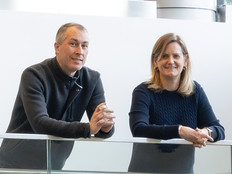Maryville University Puts 1:1 Computing at Center of Digital Initiative
Higher education institutions planning one-to-one programs have a few early adopters they can look to for inspiration and advice.
One of them, Maryville University in St. Louis, has distributed free iPad Pros to all of its on-campus undergraduate students since the 2015–2016 academic year, says Sam Harris, the university’s director of learning technology and support.
The devices, and their integration into classrooms, were originally envisioned as a central component of a wider initiative at Maryville called Digital World. Since then, Harris says, the devices have “changed absolutely everything.”
“Before we had the iPads, it was impossible to do anything technically innovative because you never knew what students would bring to class,” he says. One student might show up with a high-end laptop, for example, while another might bring a smartphone or nothing at all.
“Our one-to-one program does away with the digital divide,” he says, so that students are no longer advantaged or disadvantaged based on what device they could or couldn’t afford. “And it gives our faculty this incredible new tool — a technology they can use however they see fit.”
SIGN UP: Get more news from the EdTech newsletter in your inbox every two weeks!
Device Training Sets Up Faculty for Success
The iPad Pros come with Apple Pencils, are preloaded with course-specific apps and are integrated with the university’s learning management system, Harris says. Students are expected to bring them to every class and use them in every aspect of their academic experience.
“Taking notes, reading digital textbooks, creating presentations or collaborating on projects — it’s really up to our faculty to decide based on their needs and goals for the courses they’re leading,” says Harris.
To ensure that instructors understood exactly what they could do with the devices, in 2015, prior to launch, all Maryville faculty completed 80 paid hours of professional development focused on the iPad and active learning. Since then, Harris says, the university has offered voluntary training, and he’s made himself available to address specific questions or concerns.
“My overall sense is the faculty really like them, and the more they learn about them, the more they want to use them,” he says.
Digital Initiatives Attract Prospective Students to Campus
As for the students, Harris says, “they wouldn’t have it any other way.” Every year, Maryville asks students to rate the university on a wide range of topics.
In 2017, Harris notes, the one-to-one initiative earned a 97 percent approval rating, and more than 90 percent of freshmen cited the Digital World program as a contributing factor in their decision to attend Maryville. (The university’s freshman enrollment has surged in the last three years, up 46 percent in 2016 and another 12 percent in 2017.)
From his perspective, Harris adds, one-to-one computing is the future of higher education, an approach that he believes all institutions will eventually embrace.
“The students we have coming in now, they’ve never known a world that is not digital. Hands-on learning with technology is no longer optional,” he says. “It’s something they all deserve and expect.”







